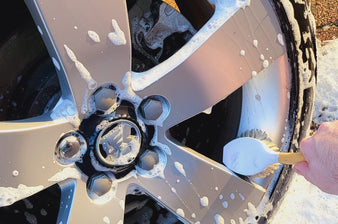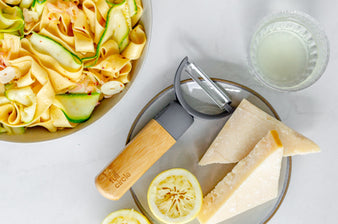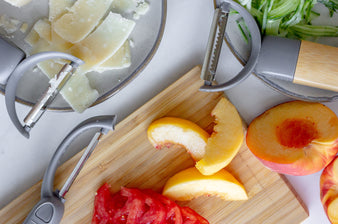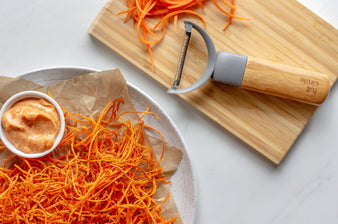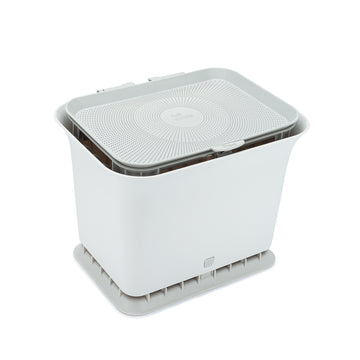Composting 101
You care about the planet. You wouldn’t be reading this if you didn’t. Life is also busy, and in our fast-paced world, it can be tough to find time for things you love like family, friends, a good cup of coffee, even reading a blog. Finding the time and energy to help fight climate change and turn our earth around so it can be there for generations of humankind? Easier than you think.
One of the best ways to help divert waste from landfills, reduce methane in the atmosphere and slow global warming: composting. That is, recycling organic matter like food waste into what is familiarly called black gold—a fertilizer that feeds the earth and growing flora.
We know, composting sounds complicated. But the best thing about it is that like many things these days, there is a spectrum, and you can find your place on it and do what works for you. We’ll show you where to start (or continue!), no matter where you are.

Level I. the Non-Committal Composter
You might be a Non-Committal Composter if you:
- have never tried composting
- don’t cook often or much
- don’t know how composting can work for you
- don’t want to collect organic waste on a regular basis
How to:
- You’ll need a compostable bag for your scraps. Since you’re not ready to commit, you don’t even have to get special bags for your scraps if you don’t want to. You can pick up a box of For Good’s zipper storage bags, which are certified compostable, and you can just use them for your snacks when you’re not collecting your compost scraps.
- Collect your organic waste on one cook (like when you’re making vegetable stock or throwing a barbecue) or over the span of a couple of days.
- Find out where in your city you can drop off your scraps here (or if the location is too far away you can also find neighbors who are composting here) and deliver your scraps.
- Congratulations, you just helped to fight climate change.
Level II: the Casual Composter
You might be a Casual Composter if you:
- have tried composting before and are ready to take it to the next level
- cook relatively often and/or have a fair amount of food scraps
- don’t have a backyard or outdoor space to create your own compost heap
- don’t want a compost heap in your backyard
How to:
- You might want to get yourself a countertop compost collector like the Fresh Air or Breeze, to keep your scraps tidy. Or you can rely on compostable bags if you have limited counter space.
- Collect your organic waste daily.
- Drop your scraps at your local spot weekly or as often as needed.
- Rinse and repeat. Oh, and feel good that you are a climate change superhero.
Level III: Committed Composter
You might be a committed composter you:
- have been composting full time or are ready to
- cook or juice daily and/or have lots of food scraps
- have a compost heap in your backyard or are ready to start one
- (OR) have an indoor electronic composter or local drop off that you visit regularly
How to:
- If you didn’t snag a countertop compost collector when you were casually composting, now would be the time to do so.
- Collect your organic waste as usual.
- Create your compost heap outside:
- Find a dry, shady spot of earth that is close to your water source
- First start with a layer of twigs, straw, anything to create drainage
- Always alternate your scraps in wet and dry layers—wet is most food scraps, dry is composed of grass, leaves, yard clippings
- Add a source of nitrogen, typically grass clippings or manure.
- Keep your compost covered so it stays moist and warm. If you ever feel like it’s drying out, give it a quick water.
- Every few weeks, turn your compost to encourage oxygen circulation. (Turning can be heavy and tough. If you want to avoid it, put a layer of the twigs and straw that you used at the start every four layers of scraps to create space for drainage and encourage air flow.)
- Watch your organic waste turn into black gold and use it to enrich your flowers, fruit and vegetable plants, and even your indoor houseplants.
- If number 3 was impossible for you because you have no outdoor space, you’ll either be using an indoor electronic composter or dropping off at your local spot where by now, they probably know your name.
- Consider yourself cool, you’re combatting climate change like a pro.
Level IV: [Black] Gold Medal Composter
You might be a [Black] Gold Medal Composter if you:
- name your worms
- have a favorite brand of alfalfa pellets
- get excited by decomposition and microorganisms
How to:
- You’re an expert, keep on doing what you’re doing.
Some quick and not-so-dirty tips on composting:
- Industrial Composting, which is generally what happens when you bring your scraps to an organic waste drop-off, can handle a lot more than your backyard compost heap. You can bring your compostable cups and plates and even the things you can’t usually compost at home.
- Speaking of things that don’t go in your home compost heap: bones, citrus peels, dairy, eggs, fish, garlic peels, meat, onion scraps, and oils and cooking fats.
And if you’re not ready for any of this, if composting is just not something you can do yet, there’s one big thing you can do that will make a huge difference to the planet but not change a thing for you: swap your regular plastic bags for compostable ones.
The average American household uses 100 trash bags each year(!)—a hundred bags degrading into microplastics and wreaking havoc on our planet. Making the switch saves the earth, one plastic bag at a time.

